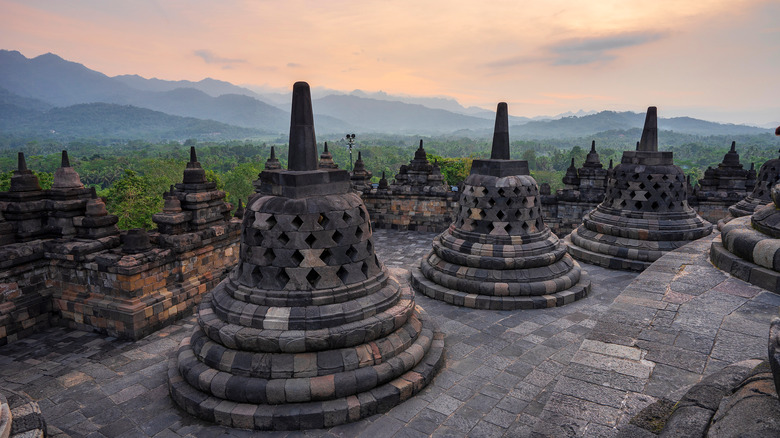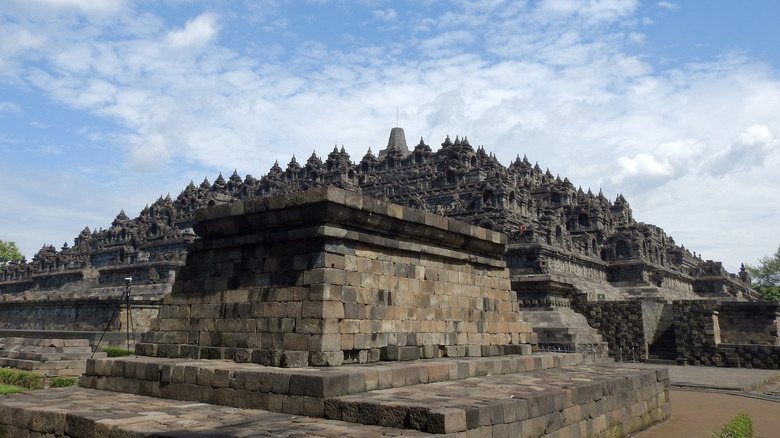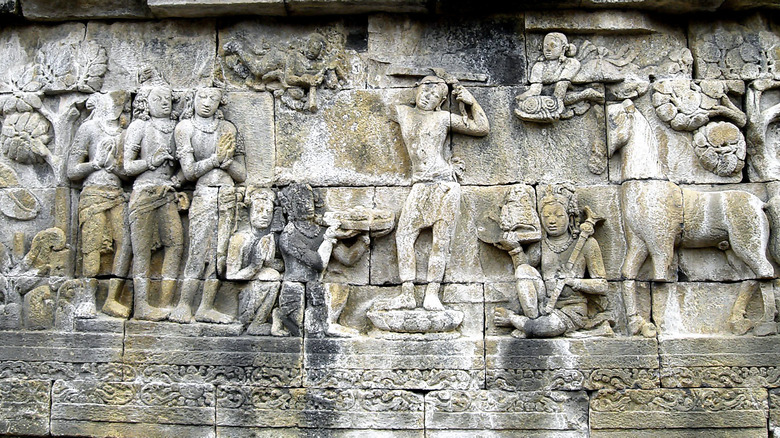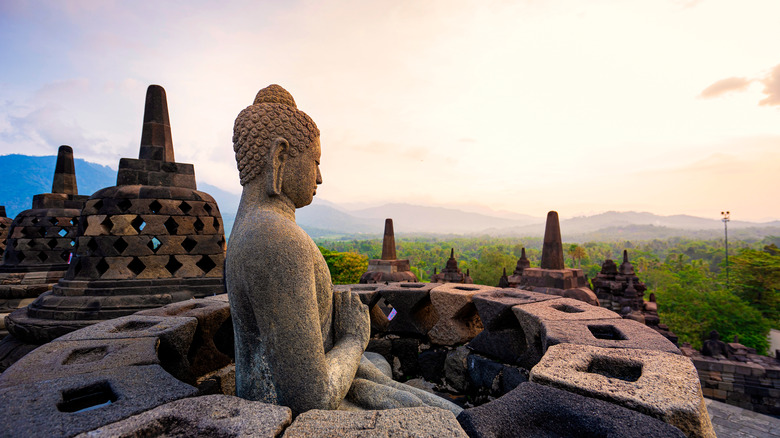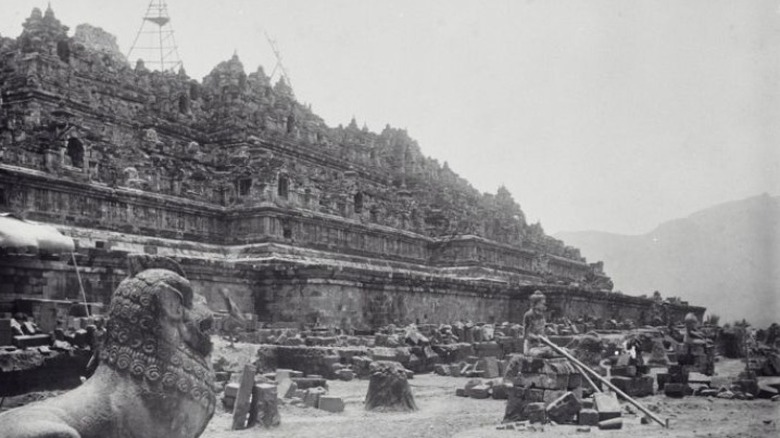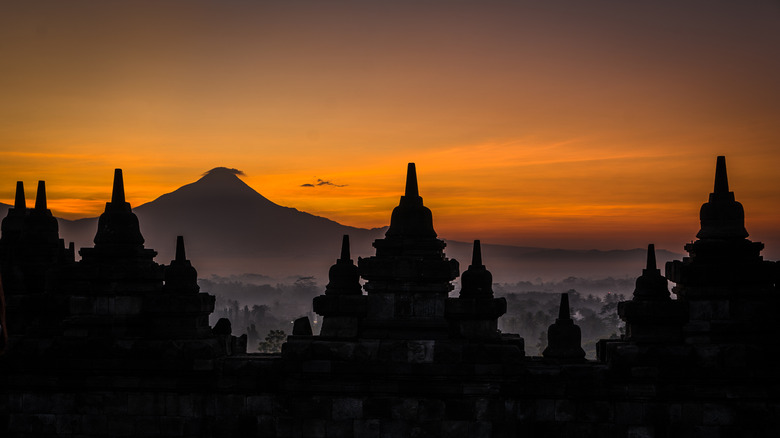How Borobudur, The Largest Buddhist Temple In The World, Was Lost For Centuries
When thinking of monumental, worldwide Buddhist architecture, lots of people might envision Angkor Wat in Cambodia, an astounding 400-acre mini-city built in the early 12th century (via History). Others might think of the cliffside monastery Paro Tanktsang located 3120 meters (over 10,000 feet) above sea level in the mountains of Bhutan, reachable only by trekking along various pilgrimage paths (via the Paro Taktsang website). Others might know about the shockingly unique Wat Rong Khun, a modern (built in 1997), pure white temple in Chiang Rai, Thailand that features, among other things, murals of Spiderman and Michael Jackson (via Slate).
Even though these Buddhist sites — and countless more besides — display a tremendous variety of design and intent, they do share commonalities. Buddhism sprang forth in India, in part, as a backlash against the rigid class hierarchy of Hindu society, following the life of Siddhattha Gautama the Buddha (566 to 486 BCE) (via the BBC). And now? Even the Buddha has been integrated into the Hindu pantheon as the ninth incarnation of the god Vishnu (via Daily Art Magazine).
Buddhism spread from India into Myanmar, Laos, Cambodia, Vietnam, Korea, Japan, Thailand, Malaysia, and more. One of those countries, Indonesia, currently contains a very small number of Buddhists — 0.7%, like India itself (via Indonesia Investments and World Data). However, it also contains one of the world's most jaw-dropping Buddhist temples, Borobudur, lost for hundreds of years under volcanic ash and rainforest foliage.
The world's largest Buddhist structure
At first glance, and from ground level, Borobudor looks like more like a fortress than a temple. It's an immense, imposing, stone step pyramid standing 42 meters tall (about 137 feet, or a 13-story building), and built on a 265-meter-tall hill (about 870 feet) (via Budowle). It is, in fact, the largest standalone Buddhist structure in the world. No mortar was used in its construction; it was built using stone transported from nearby rivers, cut into shape, and dropped into place. The builders used over 55,000 cubic meters of total stone (a whopping 1,940,000 cubic feet), while the temple's grounds cover 15,000 square meters (almost 163,000 square feet). Google Maps shows us that the area around Borobudor – in the middle of Java, one of Indonesia's larger islands — comprises a dense network of tiny rivers, which might have made construction a bit easier.
Immensity alone doesn't make Borobudor impressive, though. Walking atop its nine stacked platforms, six of which are square and three of which are circular, is like walking through an art gallery. Borobudor's entire façade is carved with 2,672 relief panels depicting a combination of sacred and historical scenes, like segments of the Buddha's life, or depictions of ancient Indian ships sailing out to nearby islands, as World History describes. There are also 504 statues of the Buddha decorating the temple, and the top tiers are capped by 72 different Buddhas, each housed within a little bell-shaped hut.
A single, massive mandala
Even though Borobudor is plenty impressive when viewed from ground level, we need a bird's eye to really understand its awe-inspiring grandeur. Viewed from above, as Curiosmos shows us, we can see that the entire temple is one, giant mandala of concentric layers. A mandala is a type of sacred Buddhist artwork, first mentioned in the Rig Veda, a Hindu text from 1,500 to 1,100 BCE (via World History). They're drawn, carved, painted, what-have-you, like sets of detailed geometric shapes nested within each other. In the end, they're meant to provoke the mind into a deeper state of awareness or insight. Mandalas migrated over to Buddhism from Hinduism, much like Hinduism's overall aesthetic sense.
From the top down, we can see that the lowest levels of Borobudor are square, and the upper ones circular. The three-mile, spiral-like path from bottom to top carries tourists and pilgrims alike on a symbolic journey of enlightenment (via World Atlas). The entire temple is divided into three, stacked levels — "kamadhatu" (desires), "rupadhatu" (forms), and "arupadhatu" (formlessness) – that represent the fundamental separation of beings within the cosmos. The Buddhas on the lowest level are housed inside little conical huts, and the ones towards the top are housed in more elaborate, bell-shaped huts called "stupa." And on the top? There's a single, central sanctum with absolutely nothing inside. This is the formlessness of the enlightened mind.
A dangerous pilgrimage into the jungle
So how in the world could such a gigantic, impressive, shockingly architected structure have gone "lost" for hundreds of years? One big clue rests in the region of Java itself, one larger island out of over 17,000 in the Indonesian archipelago. Have another look at Google Maps — Borobudor is smack dab in the middle of a dense, river-riddled rainforest. It's surrounded by new-ish settlements that have been carved into the greenery along roadways and in support of what is now a major tourist site. But back when it was built, sometime likely between 800 and 825 CE (via World History), its isolation was intentional. Temples and monasteries, like the aforementioned cliffside Paro Tanktsang in Bhutan, are supposed to be difficult to get to. It's not a soul-and-body-cleansing pilgrimage if you can just leave your front door and walk to the nearest street corner.
There are historical reasons why the site went unseen for such a long time, too. We know it was built on top of a previous, Hindu temple to the god Shiva during the reign of King Samaratungga (possibly from 790-835 CE). There were construction problems because of fighting between King Samaratungga, a Buddhist, and other Hindu monarchs of Java's Mataram kingdom. This dynasty, in fact, had built a rival, Hindu temple, Prambanan, 19 kilometers (12 miles) west of Borobudor. Even though Borobudor was a pilgrimage sight for hundreds of years, it might have been quite a risky journey.
Abandoned and rediscovered
Dangerous, and far-flung or not, Buddhists kept making the journey to Borobudor all the way to the 15th century — over 600 years. As World History says, use of the site dwindled slowly over time, rather than suddenly stopped. While we don't know exactly why, we might have Indonesia's huge influx of immigrants, traders, and travelers to thank. Islam made its way to Indonesia through Arab, Persian, and Gujarati traders as early as the 8th and 9th centuries. By around the 15th century, the time Borobudor was abandoned, Islam had become the predominant religion in the region. To this day, in fact, Indonesia is a Muslim majority (over 87% of the population, via World Data). It makes sense that interest in Borobudor may have ebbed.
On top of this, from the 10th to 11th centuries, the capital of the Mataram Kingdom moved away from Borobudur, which would have made the journey to the temple even less feasible. Volcanic eruptions and earthquakes drove people away, while rainforest growth all but consumed the temple and made it impossible to reach. The Times of India says that the site was also smothered by volcanic ash. Locals, though, never really forgot about Borobudor, and it became a thing of whispers and legends.
It took all the way until 1814 for Englishman Thomas Stamford Raffles, an important figure in the Dutch East India Trading Company, and founder of Singapore (via Historic UK), to stumble across Borobudor. Excavation began in 1907.
A major Indonesian tourist attractions
At present, anybody can visit Borobudor, albeit much more easily than ancient pilgrims (provided you've got the time and money). A host of travel sites like Trip Advisor, Lonely Planet, and Indonesia Travel feature the site, which underwent major renovations from 1975 to 1982, as Budowle states. It is also a UNESCO World Heritage Site. Borobudor is now surrounded by impeccably manicured lawns and pathways and can be reached via a one-hour drive or so from Yogyakarta to the southeast. It costs $25 for adults to enter, sunrise to sunset. There are guided tours, group rates, backpacker options, deluxe options, three nearby museums, and a bunch of ritzy and cost-friendly restaurants nearby to hit up. In addition to places like Bali and Bornea, sites like Planetware state that Borobudor is one of the main reasons to visit Indonesia. Suffice it to say, the once-lost temple will not be vanishing again any time soon.
But for those not interested in racking up Instagram likes via sunset or sunrise-backed selfies, Borobudor represents a window into the past. It's a truly remarkable site, and well-preserved, no doubt in part due to its removal from humanity for about 400 years. Take a stroll and admire scenes of the Buddha's life carved in relief along its walls, similar to stained glass in a cathedral depicting stories of saints. Or just quietly stroll around the layers of a walkable mandala along a path of Buddhist cosmology and enlightenment.
